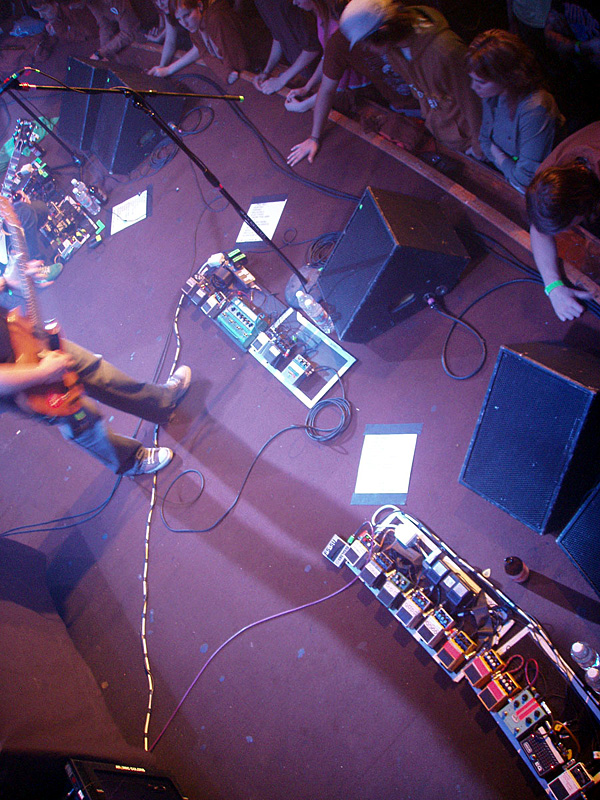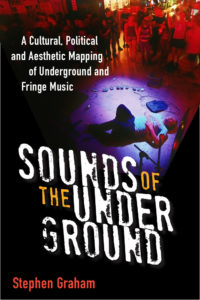Even with a space seemingly cut out for them by a family of description-defying groups, ready-made genres, and audiences lying in wait, some sounds still just seem to don’t fit anywhere. As I wrote previously about another post-something band, when genre-specific adjectives fail, we grasp at significant exemplars from the past to describe new sounds. Following Straw (1991), Josh Gunn (1999) calls this “canonization” (p. 42): The synecdochical use of a band’s name for a genre is analogous to our using metaphors, similes, and other figurative language when literal terms fall short. Where bands sometimes emerge that do not immediately fit into a genre (e.g., Godflesh, Radiohead, dälek, et al.) or adhere too specifically to the sound of one band (e.g., the early 21st-century spate of bands that sound like Joy Division), we run into this brand of genre trouble.

 Regardless, in Storm Static Sleep: A Pathway Through Post-Rock (Function Books, 2015), Jack Chuter tries to get to the bottom of all things post-rock, even devoting an entire chapter to Reynolds himself. There seems to be very little consensus on exactly where Rock crossed the line and became something else. The roots of the genre run deep and in many directions (e.g., Prog, Brian Eno, Jazz, CAN, PiL, Industrial, Jim O’Rourke, et al.), and Chuter goes as far back as the New Romanticism of Talk Talk and its separate ways before moving on to Slint and Slint-inspired rock.
Regardless, in Storm Static Sleep: A Pathway Through Post-Rock (Function Books, 2015), Jack Chuter tries to get to the bottom of all things post-rock, even devoting an entire chapter to Reynolds himself. There seems to be very little consensus on exactly where Rock crossed the line and became something else. The roots of the genre run deep and in many directions (e.g., Prog, Brian Eno, Jazz, CAN, PiL, Industrial, Jim O’Rourke, et al.), and Chuter goes as far back as the New Romanticism of Talk Talk and its separate ways before moving on to Slint and Slint-inspired rock.
If any band is worthy of its own genre, it is Slint: a band certainly more talked-about than listened-to. About such talking-about and genres as they emerge in writing, Lisa Gitelman (2014) writes,
As I understand it, genre is a mode of recognition instantiated in discourse. Written genres, for instance, depend on a possibly infinite number of things that large groups of people recognize, will recognize, or have recognized that writings can be for (p. 2).
As Star (1991) and Gunn (1999) describe canonization above, Gitelman contends that genres emerge from discourse. Subsequently, we internalize them. They are inside us. She continues,
Likewise genres—such as the joke, the novel, the document, and the sitcom—get picked out contrastively amid a jumble of discourse and often across multiple media because of the ways they have been internalized by constituents of a shared culture. Individual genres aren’t artifacts, then; they are ongoing and changeable practices of expression and reception that are recognizable in myriad and variable constituent instances at once and also across time. They are specific and dynamic, socially realized sites and segments of coherence within the discursive field (p. 2).
Chuter’s pathway through Post-Rock also goes as far out as the Post-Metal of Neurosis and Isis, and as current as 65daysofstatic, God is an Astronaut, and This Will Destroy You. Just when you think Post-Rock is too narrow a designation for a book-length exploration, with a quick list one sees how wide its waves crash.
 Further mapping the fringes, Sounds of the Underground (University of Michigan Press, 2016) by Stephen Graham covers everything from extreme noise to black metal, and from hardcore improvisation to the festivals and venues that host them. Graham distills a massive amount of cultural, political, and aesthetic history into his investigation, and his attention to the means of production, the shifting control thereof, changes in consumption, and the lack of change in content are all paramount to the story.
Further mapping the fringes, Sounds of the Underground (University of Michigan Press, 2016) by Stephen Graham covers everything from extreme noise to black metal, and from hardcore improvisation to the festivals and venues that host them. Graham distills a massive amount of cultural, political, and aesthetic history into his investigation, and his attention to the means of production, the shifting control thereof, changes in consumption, and the lack of change in content are all paramount to the story.
Graham concludes by writing, “whatever boundaries I’ve laid down should be understood as liquid and tentative” (p. 243). Noting the gauziness of genre doesn’t necessarily negate the pursuit of classification. As radically subjective as music fandom can be, it’s nice to have some signposts. These two books are maps made of many.
References:
Chuter, Jack. (2015). Storm Static Sleep: A Pathway Through Post-Rock. London: Function Books.
Gitelman, Lisa. (2014). Paper Knowledge: Toward a Media History of Documents. Durham, NC: Duke University Press.
Graham, Stephen. (2016). Sounds of the Underground: A Cultural, Political, and Aesthetic Mapping of Underground and Fringe Music. Ann Arbor, MI: University of Michigan Press.
Gunn, Josh. (1999, Spring) Gothic Music and the Inevitability of Genre. Popular Music & Society, 23, 31-50.
Straw, Will. (1991). Systems of Articulation, Logics of Change: Communities and Scenes in Popular Music. Cultural Studies, 5(3), 361-75.
——–
Apologies to Josh Gunn for the title of this post.
I marshal the middle between Mathers and McLuhan.
Editor of Boogie Down Predictions (Strange Attractor, 2022), author of Dead Precedents (Repeater, 2019) and The Medium Picture (UGA Press, 2025), among others.
